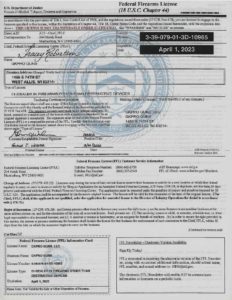
OK, there is no “best” shooting stance for self-defense. Let’s get that out of the way. As with most things in life, the “best” is situational and personal.
But there are reasons to utilize one compared to the other, and knowing the when, why and where are important.
There are three primary shooting stances. I will review each of them and the modifications to them.
1. Bull’s Eye or Power Point Stance
This is a one-handed shooting stance. It is the least useful of the stances for self-defense, assuming you have use of both hands.
The main difference between Bull’s Eye and Power Point is the placement of the off-hand. In Bull’s Eye it is typically placed on the hip, with Power Point placing it high on the chest in a balled fist.
Both locations are to ensure it does not get struck while firing.
This is a bladed stance, with the shooting hand pressed all the way forward with a rigid (if not locked) arm.
The shooter’s body faces 90-degrees away from the target, with the head facing down the length of the extended arm.
This provides a very slim profile against return fire and is a very precise method of aiming. The downside is the method is very slow for target acquisition and recoil is poorly managed, especially by those not accustomed to shooting.
Follow-up shots are very slow and if the situation devolves to hand to hand, this position is far from optimal.
All that being said, you should practice one of these variants. It is the defacto shooting stance when your off-hand is occupied. For its faults, there are times when it is impossible to take a two-handed stance. For example:
- You are carrying a baby in your off-hand when a dog attacks.
- Three plastic bags full of groceries weigh down that hand when a mugger jumps from behind the bushes.
- Your hand is in a cast due to a poor skateboarding decision.
This brings us to two-handed stances. There are two primary choices here: Isosceles and Weaver. First up is Isosceles.

2. Isosceles Shooting Stance
This is a symmetrical stance where the shooter is squarely facing the target with both hands on the pistol.
Both arms are rigid or locked forward, forming an isosceles triangle, with the pistol at the acute angle closest to the target.
The feet are shoulder-width apart, with neither placed in front or behind the other and toes facing the target. Typically, the legs are kept fairly straight.
This method provides a very quick and intuitive position. The sights come naturally into alignment with the head in an upright position.
Visibility is easily maintained to 90 degrees to the left and right of the shooting direction.
For those who are wearing armor, this also provides the best protection as the square facing to the threat limits exposure of less-protected areas.
The shooter presents a larger target, but most vital areas are protected.
There are drawbacks to Isosceles. Transitioning past 60-70 degrees requires slow footwork. Having both feet in the same plane does little to control recoil.
This lack of front to back stability increases follow-up shot time. If the shooter is standing upright, instead of in a crouch, even low-recoiling rounds like 9mm Luger can cause the feet to shuffle in an attempt to maintain stability.
This weakness extends into hand-to-hand combat if the threat is not neutralized with the firearm….
There is more, but you have to go to The Shooter’s Log site to read the rest. I got yelled at by their Editor once… Here is the link>> https://blog.cheaperthandirt.com/best-shooting-stances…..













Recent Comments